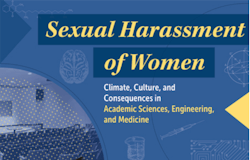Report says universities need to overhaul how they deal with sexual harassment
Years of efforts to prevent sexual harassment of women in the fields of science, engineering and medicine have not succeeded, and universities and institutions need to overhaul how they deal with the issue, a new report says.
The New York Times says that the report from the National Academies of Sciences, Engineering and Medicine makes 15 detailed recommendations, some of them overturning long-entrenched systems of funding and mentoring in academia. It calls for significant changes to academic advising practices so that students and junior researchers are not dependent on one senior researcher for mentoring and access to grants.
“Despite significant attention in recent years, there is no evidence to suggest that current policies, procedures, and approaches have resulted in a significant reduction in sexual harassment,” the report states.
The 311-page document, "Sexual Harassment of Women: Climate, Culture, and Consequences in Academic Sciences, Engineering, and Medicine," is the National Academies’ first report addressing sexual harassment.
The report says there is often a perceived tolerance for sexual harassment in academia because of its history of being male-dominated; the informal ways that people in academic environments communicate; and intensive research projects that can be isolating because they involve small numbers of people.
Academic workplaces are second only to the military in the rate of sexual harassment, 58 percent of academic employees indicate they had such experiences, according to one study cited.
The report identifies three types of sexual harassment: sexual coercion, unwanted sexual attention and gender harassment. It said gender harassment, “verbal and nonverbal behaviors that convey hostility, objectification, exclusion or second-class status,” was by far the most common type women in these fields experienced.
